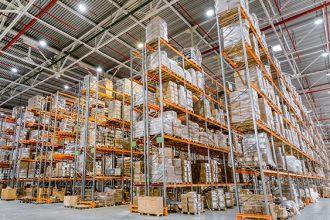Best Practices In Safe Operation Of Pallet Flow Rack

Pallet flow rack (also sometimes called “gravity flow”) is a high-density, dynamic storage system engineered to hold up to 20 pallets in a single lane. Loaded back to front for first-in/first-out load access, the pallets ride atop gravity wheel or roller lanes mounted at a slight pitch that slopes downward from the loading point to the pick face. These systems are ideal for storing multiple pallets of the same product, particularly fast movers.
Because it relies on gravity to move the loads through the lane—as opposed to a mechanized device—pallet flow rack requires fairly precise pallet placement. A lane of pallets also generates a significant amount of force, particularly on the load at the pick face. Therefore, it’s important to ensure operators are well versed in the best practices for safe operation of pallet flow rack at three key points: loading, unloading and clearing a hang-up within a lane.
Safe Loading (also called “Charging”) Practices: For safe and proper pallet placement, the fork truck must be positioned squarely to the opening side of the lane, with the center pallet stringer aligned with the center flow lane. (To further ensure correct pallet positioning, optional entry guides can be added to the outside of the flow rails at the point of entry, helping to straighten an off-center pallet.)
The load should be raised 2-3 inches above the lane rollers. Once in position, the forks are tilted forward, allowing the pallet to first make contact with the rollers or wheels, then roll away from the vehicle and down the lane until it meets the preceding pallet load. When placing the load, it’s important to avoid contact between the fork tips and the lane wheels, and to not place pallets with broken or missing bottom boards into the system, as either instance could cause a jam within the lane. After placement is complete, the forklift should back away from the opening completely prior to turning to avoid an impact with the uprights.
Safe Unloading Practices: For safe and proper pallet removal from the discharge/pick face end of a lane, the forklift should first be aligned square to the rack face prior to entering the pallet’s fork openings. Once the pallet is on the forks, it should be lifted to a level position high enough to clear the front beam, yet still low enough to make contact with the loaded pallet behind it. Before extracting the pallet, the forklift operator should gently push it back against the subsequent pallet load to help start forward flow of the rest of the lane; after slowly removing the pallet, the remaining loads will advance to the aisle face. (If they don’t advance, refer to the “Safe Jam Clearing Practices” section below.)
Safe Jam Clearing Practices: First, operators should never climb into a live flow system to attempt to clear a stuck pallet, as the risk of a serious injury is high. Instead, a technique known as “plugging” is recommended. To begin, a forklift positioned squarely at the discharge/pick face end of the lane lifts the front pallet 1-inch above the rollers. Once lifted, the forklift uses the pallet to firmly push (or bump) the pallet load behind it by 3-4 inches. As the forklift backs out with the first load onboard, the subsequent loads should follow.
If this does not work, the removed pallet should be replaced in the pick face position and the entire system should be inspected to identify and address the blockage.
Looking for more storage rack safety guidelines? RMI will be presenting a free educational seminar, “Storage Rack Safety 101,” on Wednesday, April 10 at ProMat 2019 in Theater F at 11:15 a.m.


